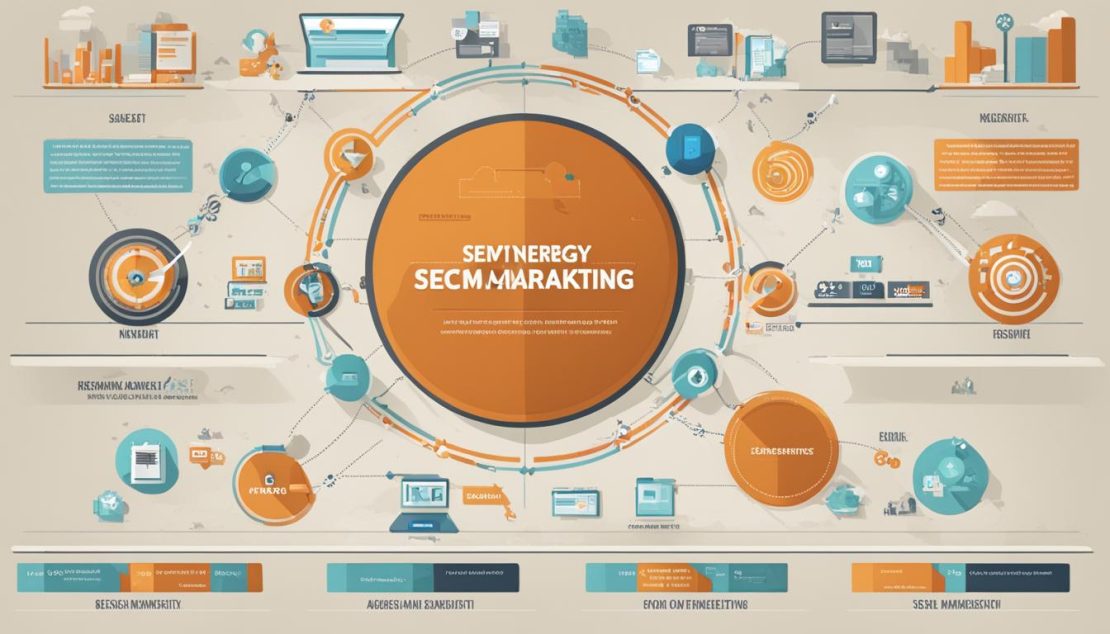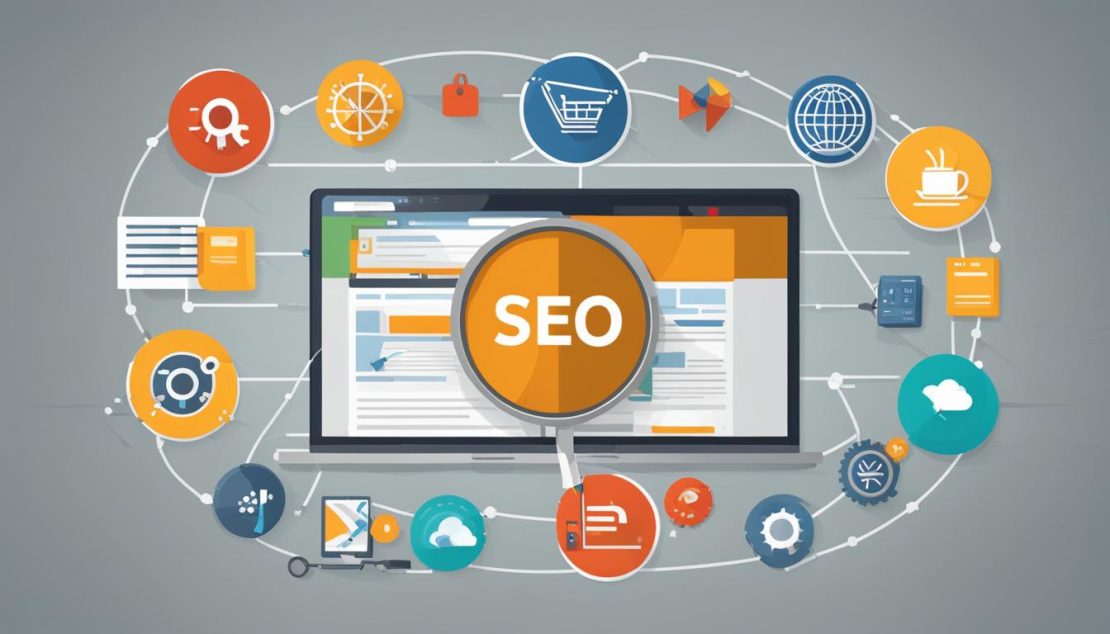In the realm of digital marketing, mastering both SEO strategies and SEM tactics is key to securing a dominant online presence. As cornerstones of Internet marketing, these approaches are not standalone silos but are two sides of the same coin, indispensable for boosting search engine visibility and reinforcing online branding. With the ever-growing competition for consumer attention, companies that skillfully navigate the interplay between SEO and SEM are those that stand out and succeed.
Drawn from a deep understanding of market dynamics and consumer behavior, an integrated approach to SEO and SEM unlocks new opportunities for businesses to connect with their audience. As the digital landscape continues to evolve, staying ahead means not only knowing the principles behind these strategies but also aligning them in a harmonious digital symphony that resonates with potential customers. Let’s explore how they come together to form a robust framework for your brand’s online growth.
Understanding the Basics of SEO and SEM
In the realm of digital marketing, acquiring a solid grasp of search engine optimization (SEO) and search engine marketing (SEM) is indispensable for achieving success. Both practices aim to boost visibility in search engine results, but they approach this goal through different strategies. Let’s delve into what each term encompasses and how they synergistically contribute to your online presence.
Defining SEO: The Art of Organic Ranking
SEO stands for search engine optimization, a complex amalgamation of techniques designed to increase a website’s prominence in organic search results. This involves a multitude of page ranking factors, including the creation of high-quality content as part of a broader content marketing strategy, ensuring websites are structured effectively for easy navigation, and securing relevant backlinks. Technical aspects, such as improving site speed and delivering a mobile-friendly user experience, also play significant roles in enhancing SEO.
Exploring SEM: The Power of Paid Search
When it comes to SEM, or search engine marketing, the focus shifts to the sphere of paid search advertising. Platforms like Google Ads or Bing Ads provide businesses with the opportunity to create targeted adverts that display alongside search results. These campaigns, known as PPC campaigns, offer immediate visibility for specified keyword targeting, injecting a business’s message right where potential customers are searching. The direct nature of SEM can yield a higher click-through rate, making it a compelling option for reaching a target audience swiftly.
The Synergy Between SEO and SEM Strategies
SEO and SEM are not mutually exclusive and, when used cohesively, can amplify a brand’s online marketing efforts. The foundational strength of SEO, with its focus on organic growth, provides a strong base from which SEM strategies can launch, allowing for quick testing of keywords and market hypotheses. Insights gleaned from SEM activities can feed back into SEO tactics, fine-tuning efforts for organic reach based on the data-driven revelations from paid search campaigns. This symbiotic relationship underscores the importance of employing both search engine optimization and search engine marketing in a unified digital strategy.
The Complementary Nature of SEO and SEM Work
When it comes to reaching online audiences effectively, integrating digital marketing strategies is less an option and more a necessity. This integration emphasizes the pairing of search marketing tactics, such as combining SEO and SEM, to establish and maintain long-term brand visibility. SEO, with its cost-effective marketing approach, solidly supports the building of organic visibility over time, while SEM offers the flexibility of an adjustable and immediate presence in the market.

Successful marketers understand the dance between the gradual yet steady growth of SEO and the agile, direct results-driven nature of SEM. By marrying these two, a synergistic effect occurs, paving the way for a robust online reputation and an expanded digital footprint.
Integrated strategies leveraging both SEO and SEM not only conserve marketing budgets but also optimize overall performance, ensuring every dollar is used to its maximum potential.
- SEO paves the way for credibility and organic engagement.
- SEM propels immediate brand recognition and lead generation.
- The fusion of SEO and SEM tailors a marketing approach that is responsive to market trends and consumer behaviors.
| Strategy | Timeframe | Cost Effectiveness | Goal Alignment |
|---|---|---|---|
| SEO | Long-term | High | Building Trust & Authority |
| SEM | Short-term Immediate | Medium | Quick Market Penetration |
In conclusion, a strategic, well-implemented integration of SEO and SEM paves a dual-path way to not just surviving, but thriving in the digital marketing arena. The dual harnessing of organic and paid methodologies not only enriches user experiences but also forms a comprehensive funnel for capturing a wide spectrum of leads.
Maximizing Visibility Through SEO and SEM Integration
An integrated marketing approach is essential in today’s digital landscape, especially when it comes to enhancing search engine rankings. The synergy of SEO and SEM alignment not only broadens a brand’s reach but also fortifies its presence across various channels. Let’s delve into how strategic keyword research, content optimization, and a harmonious application of SEO and SEM can significantly boost your web presence and cross-channel marketing efforts.
How Combining SEO and SEM Benefits Your Overall Web Presence
Invigorating your brand’s web presence requires a tapestry of strategic maneuvers that intertwine the adaptive prowess of SEM with the foundational strength of SEO. This blend paves the way for a robust platform rich in high-quality content that earns trust and an SEM-driven spotlight that targets and captivates the right audience.

Strategic Keyword Alignment for SEO and SEM
To prevent the cannibalization of your marketing efforts and to clarify the searcher’s intent, a meticulous alignment of keywords used in both SEO and SEM is imperative. This strategic move ensures that whether customers find you through organic search or paid ads, they receive consistent messaging that maximizes your brand exposure and optimizes your marketing budget.
| Keyword Research Phase | SEO Application | SEM Application |
|---|---|---|
| Identifying Target Keywords | Content creation based on audience interest and search trends | Ad copy and keyword bidding for targeted campaigns |
| Analyzing Competitor Keywords | Understanding gaps and opportunities in content strategy | Competitive positioning in ad placement |
| Ongoing Keyword Evaluation | Refining content and meta tags for better organic reach | Adjusting bids and ad focus based on performance metrics |
Content Strategy: Using SEO Insights to Enhance SEM
A streamlined content strategy that bridges SEO and SEM can significantly elevate the impact of your marketing campaigns. By utilizing insights gained from SEO efforts, such as high-performing keywords and user engagement patterns, we can craft SEM campaigns that resonate deeply with our audience, leading to more impactful and cost-effective advertising.
- Refining ad copy with popular organic search terms
- Using content themes that drive SEO success to inform SEM creative
- Applying behavioral analytics to improve targeting and relevance
Effective Tactics to Merge SEO and SEM Efforts
In today’s interconnected digital landscape, merging SEO and SEM efforts is more than just a best practice; it’s a competitive necessity. By utilizing robust cross-channel analytics, marketers can distill actionable insights that propel both organic and paid search to new heights of efficiency and effectiveness. Below, we explore how to make the most of both worlds, utilizing data to drive a cohesive digital marketing strategy.
Utilizing Analytics to Improve SEO and SEM Performance
Data is the linchpin in the pursuit of merging SEO and SEM strategies effectively. Platforms such as Google Analytics provide invaluable SEO analytics, offering a clear view of user behavior, search patterns, and conversion metrics. This SEM performance data isn’t just numbers; it’s a roadmap to user engagement, helping brands tailor their presence to meet customer needs precisely. By understanding these patterns, businesses can refine their strategies for greater visibility and engagement.
Leveraging SEM Data for SEO Content Opportunities
SEM’s real-time reporting offers a treasure trove of insights that can be harnessed to enhance SEO-driven content creation strategies. For instance, identifying which ad copy leads to the highest conversion rates can reveal the messaging that resonates with your audience—a priceless piece of intelligence that can be woven into organic content to enrich SEO efforts. This cross-fertilization of ideas ensures a brand’s voice is not only consistent but also compelling across all search mediums.
Adjusting Bidding Strategies Based on SEO Insights
Bid management in SEM doesn’t operate in a vacuum. Instead, it should be informed by SEO-driven SEM optimization. By using SEO insights, such as keyword rankings and organic search traffic data, marketers can fine-tune their SEM bid strategies. The aim is to allocate resources where they’re most effective, reducing cost-per-click and capitalizing on the organic ranking strength to maximize ROI. Such a data-driven approach ensures that every marketing dollar is working harder and smarter towards achieving your business goals.

